Last updated: July 22, 2022
Article
Captain Nathan Appleton
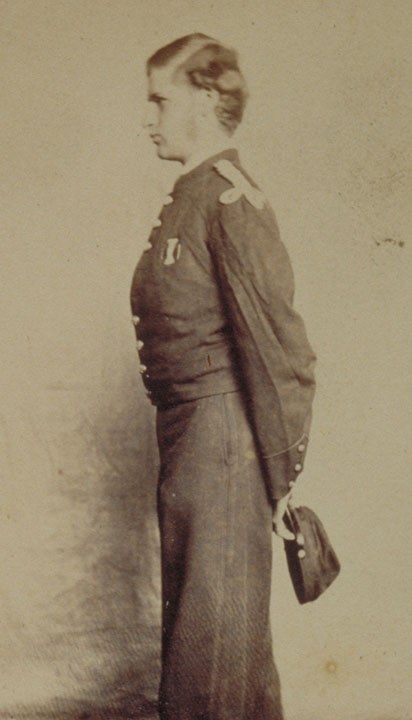
Charles Appleton Longfellow Papers, Longfellow House-Washington's Headquarters National Historic Site (1008.2/1.2-2#15)
Nathan Appleton Jr., born February 2, 1843, was the son of Hon. Nathan Appleton and his second wife, Harriot Coffin Sumner, making him brother-in-law to Henry Wadsworth Longfellow. Nathan studied at Harvard College, starting in 1859, just shy of two years before the Civil War officially began, but he often reflected upon the tension between the North and the South in his letters to friends and family. Nathan chose, at the insistence of his mother, to finish his studies before enlisting in the United States Army, but this did not stop him from staying up to date on the state of the war and keeping track of the classmates that did leave to fight, including those from the South. Later on, Nathan reflected on these days in Harvard College During the War of the Rebellion (1891): “We graduated in July, 1863, when the early enthusiasms had passed away; there was no novelty in the situation, and those who entered the army then had learned that it was not to be the ninety days’ picnic as first supposed.”1
To the Battlefield
Despite choosing the classroom over the battlefield, Nathan’s curiosity for the war demanded attention. He traveled to the South, including Washington, D.C. and North Carolina, to spend time with friends from Harvard and their relatives. In a letter to his mother, Nathan remarked that he was taking note of Confederate uniforms “for future reference.”2 Finally, in 1863, he graduated from Harvard and was soon after joined the Army of the Potomac as an officer in the Fifth Massachusetts Battery, Light Artillery. At just 20 years old, Nathan was made Second Lieutenant. He was mustered into service on August 21, soon joining his unit in Virginia.
Nathan sent letters to his family often, most often his mother and his sister Harriot “Hattie” Sumner Appleton, sharing developments of the War, the conditions of the camps, the people and places he encountered, and his day-to-day activities. Nathan was particularly fond of horses and had one he kept by his side throughout the war, whom he named “Folko.” He would often ask his mother and sister to share news from home and send him various items to make life on the battlefield easier, such as money, sewing supplies, gloves, and clothing.3 He also made efforts to keep in contact with his nephew, Charles Appleton Longfellow, who was with the First Massachusetts Cavalry as an officer. Despite their familial relation, the two were only a year apart in age and more like cousins. They traveled to Russia together after the war ended. In September of 1863, the two found themselves camped near each other. Nathan visited his relative and dined with him later that day.4 When Charles was wounded, Nathan visited him in the hospital twice, though, by the second visit, Charles had been released.5
Nathan and his unit made their way to Rappahannock Station in Virginia, and saw action nearby at the Mine Run Campaign, Spotsylvania, and the Battle of the Wilderness.6 Reaching the North Anna River in May of 1864, Nathan wrote to his mother on the 24th that there were “skirmishes almost every day…the constant marching and fighting is very tiresome.”7 Just one day later, Nathan was injured during a skirmish in the woods near the railroad. He was hit in the right arm, the bullet passing through and grazing his right leg.8 He was granted thirty days leave by the surgeon and took that time to travel and recuperate. First visiting New York, Nathan eventually made his way to Europe, where he spent time with family and friends in Paris, Italy, Germany, and London. Once healed, Nathan was unable to straighten his arm completely since it had been bent within a sling for so long. Doctors initially recommended he correct it using electrical currents but was later told in Italy that “gymnastic exercise” would suffice.9
Having traveled and recovered over the course of a year, Nathan was determined to see the end of the war. In 1865, he volunteered with his old corps as an aide-de-camp to Colonel Wainwright, commander of the 5th Corps Artillery Brigade, and was promoted to Brevet Captain. He was present for General Lee’s surrender on April 9 and participated in the army’s Grand Review through the streets of Washington, D.C., before returning home for a short while. Following Lee’s surrender, Nathan heard of the assassination of President Lincoln and solemnly wrote to his mother: “the blow as it comes is terrible. Who can take care of us as he did?”10
The Life of a Veteran
While the war ended for the country that day in April, it never truly left Nathan’s mind and soul. He remarked shortly before being wounded that, “Anyone who has gone through such a scene as this would not feel inclined to settle any matter by war…It will take a big inducement to make me engage in another war.”11 Nathan resigned from the army, but the impact the experience left on him was certainly undeniable. Immediately following the war, he spent time traveling to Russia with Charles Longfellow and then later to Paris and various other nations alone as he became an entrepreneur and diplomat. Involved in banking, French-American relations, and the building of the Panama Canal, Nathan filled his spare time with numerous charitable associations. While this included personal endeavors such as the Massachusetts Society for the Prevention of Cruelty to Animals, the Sons of the American Revolution, and the Mayflower Society, Nathan dedicated much of his time to veterans associations.
Once the war was over, veterans of the US Army found themselves unable to simply move on from their experiences. They continued to feel a sense of brotherhood and duty. The sacrifices of veterans, both physical and mental, went underappreciated by the public. Promises made by politicians to provide for these men were unfulfilled.12 This led to the organization of multiple fraternal societies that allowed veterans to gather, exchange stories, and care for each other. Nathan was one of these men, and with a prominent name in Boston society (along with the rank of an officer during his entire military career), he was elected to several leadership positions. Most prominently, Nathan belonged to two veterans organizations: The Grand Army of the Republic and the Society of the Army of the Potomac.
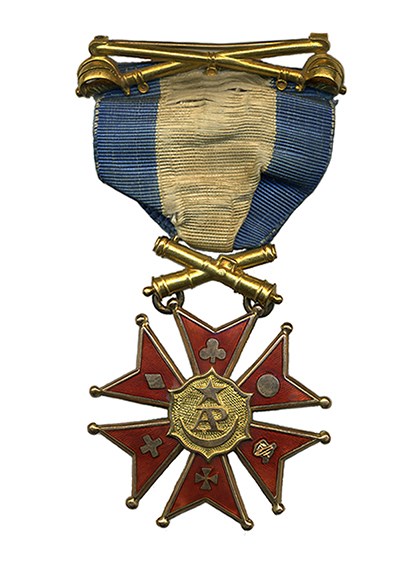
Museum Collection, Longfellow House-Washington's Headquarters National Historic Site (LONG 23820)
Society of the Army of the Potomac
The Society of the Army of the Potomac was founded in 1869 and was specifically for men who served in the Army of the Potomac, which was comprised of eight army corps. Nathan was a member of the Fifth Army Corps, represented by the Maltese Cross symbol. He joined the Society in 1871 after taking some time to travel and was elected in 1889 to represent the Fifth Army Corps as one of the Vice Presidents. Members of the organization were given gold badges, which included the crossed sabers of the cavalry, a pair of crossed cannons, and eight insignias representing the corps. Nathan was invited to attend their annual meeting at the Parker House (now the Omni Parker House) in 1893.
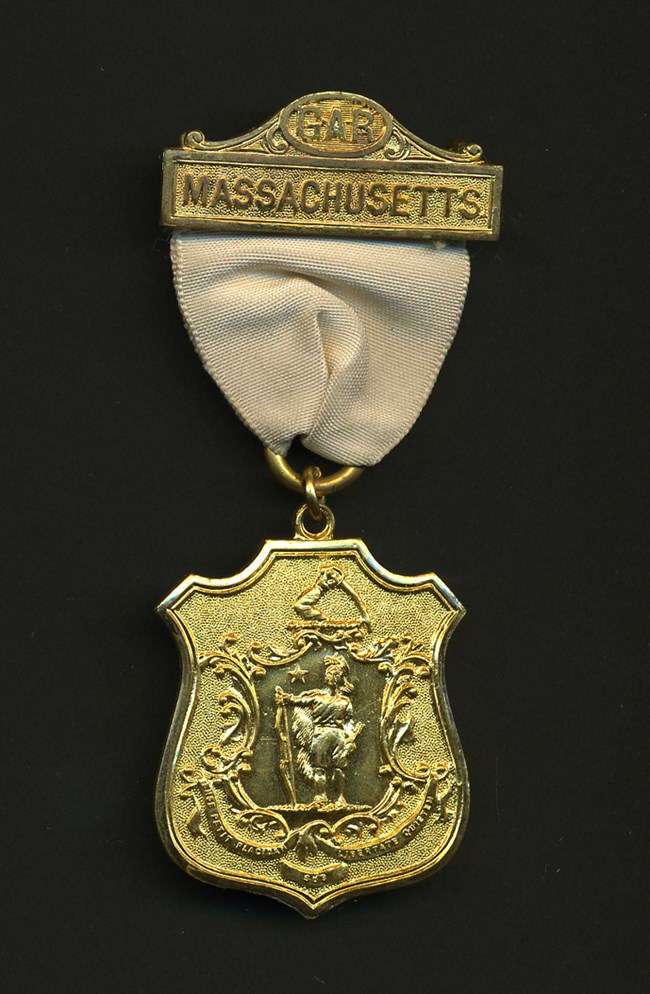
Museum Collection, Longfellow House-Washington's Headquarters National Historic Site (LONG 23817)
Grand Army of the Republic
Appleton was also a member of the Grand Army of the Republic (G.A.R.), the largest veterans organization in the country. Their motto represented the tenants the organization based their work on: Fraternity, Charity, and Loyalty. Unlike the Society of the Army of the Potomac, the G.A.R. was not regional and encompassed all who served in the US Army between 1861 and 1865 and were honorably discharged. Each participating state had its own department, Nathan being a member of the Massachusetts Department, for which he received a gold badge. Within these departments were a series of posts that corresponded to different counties and locations. Only one post served the white veterans of Suffolk County, Massachusetts, that being the E. W. Kinsley Post 113. Appleton served as its commander in 1877 and 1878.
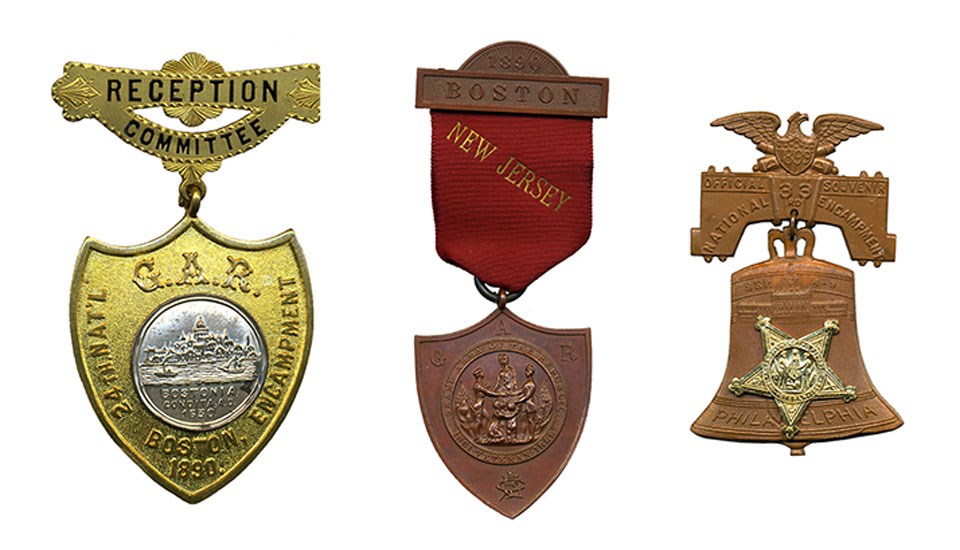
Museum Collection, Longfellow House-Washington's Headquarters National Historic Site (LONG 23809, 23816, 23811)
The primary programming of the G.A.R. was the National Encampment, an annual reunion held in a different city each year hosted by nearby posts. The first was held in 1866, hosted by the city of Indianapolis. These reunions allowed veterans to meet with each other, participate in grand spectacles such as parades, and, if they were prominent enough in rank and society, dine with officers and politicians. Nathan attended several National Encampments, such as the 33rd National Encampment in 1899, held in Philadelphia. Attendees often received souvenir medals to mark their participation in the encampment, which were also sold to the public. Nathan brought home a bronze one in the shape of the Liberty Bell. 1890, though, was an important year for Nathan and his post. Boston hosted the 24th National Encampment that August. He was a member of that year’s Reception Committee to aid in the planning of the festivities and suggested that they place a naval display in the harbor. This idea received much appreciation and was communicated to the Secretary of the Navy, the Hon. B. F. Tracy and approved.13
Encampments weren’t the only events that G.A.R. members attended. Individual posts also held their own affairs, such as meetings, dinners, and bonfires. Nathan was a well-respected member of the G.A.R. and was often invited to speak at events for other posts. He spoke at Boston’s Charles Street A.M.E. Church on May 9, 1895, for the Robert A. Bell Post 134, the first all-Black G.A.R. post in the country.14 These meetings fostered a sense of community amongst veterans. Their motto of fraternity was taken seriously. The G.A.R. was criticized by Harvard University President Charles William Eliot in 1896, calling it “an organization which does little more than get what money it can from the Government.”15 In return, Nathan criticized Eliot in the Boston Journal for his hypocrisy in memorializing the Federal soldiers who died in the war while also turning his back to the veterans who remained. He called the G.A.R. “the most important organization in every way of the survivors of the Union forces.”16 Nathan felt a strong sense of devotion and passion for the organization.

Museum Collection, Longfellow House-Washington's Headquarters National Historic Site (LONG 23814)
The brotherhood veterans felt at National Encampments was not limited to their participation and attendance; they often traded medals with each other as a symbol of their comradery. Nathan received one from the 1890 Boston Encampment from a New Jersey Department member. While the original owner of this medal is unknown, delegates from other states often wore souvenir medals with their state stitched into the ribbon, acting as a representative. A more personalized gift, though, was a medal Nathan received from Major George P. Edgar of Lafayette Post 140 in New York City. The two met earlier, most likely at the Post 113 23rd Anniversary Banquet, where Post 140 joined in the celebration.17 Major Edgar was sent as one of the representatives of his post. After attending the 1892 26th National Encampment in Washington, D.C., Major Edgar took the time to have his and Nathan Appleton’s names and posts engraved on the back, making the bond between veterans permanent.
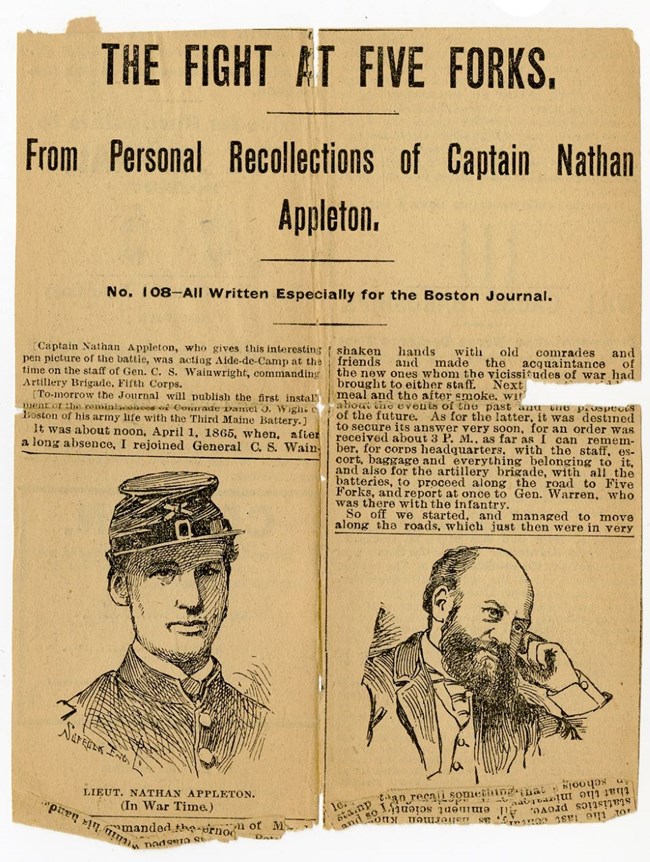
A Lasting Legacy
The war had a profound impact on Nathan long after its end. He wrote several memoirs and articles detailing his experiences on the battlefield, including the Battle of Five Forks, the anniversary of General Lee’s surrender, his memories of Appomattox, and his campaigns with Phillips’s Battery. In his article “War Memories: The Last Gun at Appomattox,” he wrote:
Only two or three schrapnel shots had been fired, when the welcome news was passed along that the white flag of truce was to seen somewhere on the lines, and in concordance to its mission the noise of artillery and musketry ceased, — thank God, not to be renewed again.
The 9th of April was a memorable day for the land. The great and principle [terrible] agony was over, and, while there were jollifications and phrensied expressions of gladness all through the Northern cities, I doubt if there could have been two men more deservedly happy than Abraham Lincoln and Ulysses S. Grant.18
However, the conflict itself was not all that persisted in Nathan’s consciousness. Following the War, Nathan became a self-proclaimed “carpet bagger” and bought a plantation on Edisto Island, South Carolina, where he planned to harvest sea cotton and appointed a friend as its manager.19 This particular venture was fruitless. Nathan also advocated for the rights and safety of African Americans in this new period of freedom. He was vehemently against the lynching of African Americans in the South, speaking once more at the Charles Street A.M.E. Church in Boston by invitation of the Colored National League, condemning the culture of lynching that was taking hold in Texas, calling it a racial, social, and political trouble.20 Nathan “accused the Southern whites for inventing imaginary crimes to charge against the negroes as a pretext for suppression and disfranchisement” due to bitterness over the results of the war.21 Meanwhile, he criticized states’ apathy towards the 14th and 15th Amendments by not securing citizens’ right to vote.22 The legacy of the war within the lives of African Americans impacted his moments of advocacy and moral standing.
While Nathan Appleton’s post-war life moved forward, often consumed by business ventures and charities, his service in the Fifth Massachusetts Battery was never left behind.
- Meghan Arends, 2022
Notes
- Nathan Appleton, Harvard College During the War (Boston: New England Magazine, 1891), 3.
- Nathan Appleton to Harriot (Sumner) Appleton, 3 February 1862. Appleton Family Papers Box 9, Massachusetts Historical Society, Boston.
- Nathan Appleton to Harriot (Sumner) Appleton, 23 September 1863. Appleton Family Papers Box 9, Massachusetts Historical Society, Boston.
- “Letter from Nathan Appleton, 23 September 1863.”
- Nathan Appleton to Harriot (Sumner) Appleton, 8 December 1863. Appleton Family Papers Box 9, Massachusetts Historical Society, Boston.
- “5th Massachusetts Battery,” The Civil War in the East, https://civilwarintheeast.com/us-regiments-batteries/massachusetts/5th-massachusetts-battery/.
- Nathan Appleton to Harriot (Sumner) Appleton, 24 May 1864. Appleton Family Papers Box 9, Massachusetts Historical Society, Boston.
- Nathan Appleton, “About my Wound,” 1875. Appleton Family Papers Box 14, Literary Sketches, Massachusetts Historical Society, Boston.
- Nathan Appleton, “Letter/Notes from Italy, 27 November 1864.” Appleton Family Papers Box 9, Massachusetts Historical Society, Boston.
- Nathan Appleton to Harriot (Sumner) Appleton, 17 April 1865. Appleton Family Papers Box 9, Massachusetts Historical Society, Boston.
- Nathan Appleton, “Journal, 1863-1864,” Private Collection.
- Brian Matthew Jordon, Marching Home: Union Veterans and Their Unending Civil War (New York: W.W. Norton, 2014), 83, 162.
- “Souvenir Twenty Fourth National Encampment Grand Army of the Republic: Boston – 1890,” Grand Army of the Republic, 1890, 40.
- Colored National League, “Massachusetts Condemns Lynch Law,” 1895. Appleton Family Papers, Vol. 56, Massachusetts Historical Society.
- Nathan Appleton, “Veteran’s Rebuke,” Boston Journal, 21 May 1896. Appleton Family Papers, Vol. 56, Massachusetts Historical Society.
- Ibid.
- “Comrades in Reunion,” 1895. Appleton Family Papers, Vol. 55, Massachusetts Historical Society.
- Nathan Appleton, “War Memories: The Last Gun at Appomattox.” Appleton Family Papers Box 29, Massachusetts Historical Society.
- Nathan Appleton, “Address Delivered by Captain Nathan Appleton, Before Robert A. Bell Post 134, Department of Mass. G.A.R., at the Charles Street Church, Boston, Memorial Day, May 30, 1891.” Appleton Family Papers Box 15, Massachusetts Historical Society.
- “Negro Lynching: Protest of the Colored National League of Boston,” 20 November 1895. Appleton Family Papers, Vol. 56, Massachusetts Historical Society.
- Ibid.
- Nathan Appleton, “Burning Issue: Nathan Appleton Says It Comes Directly From Slavery and the War,” Boston Daily Globe, 31 October 1892. Appleton Family Papers, Vol. 55, Massachusetts Historical Society.
